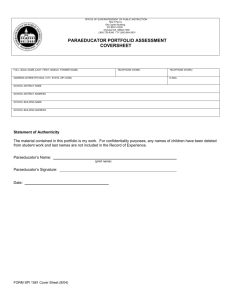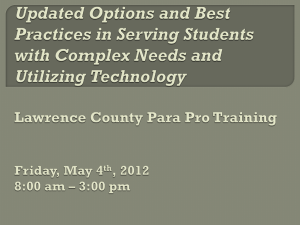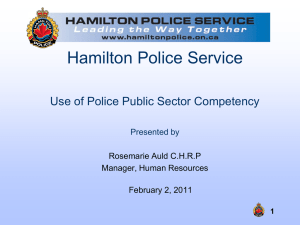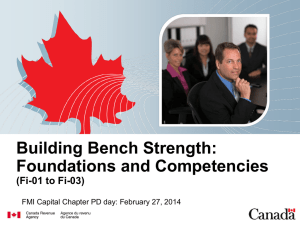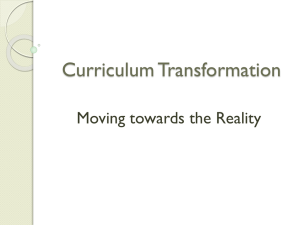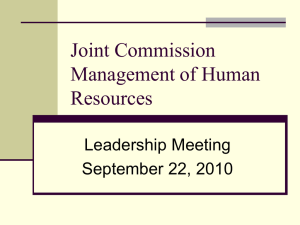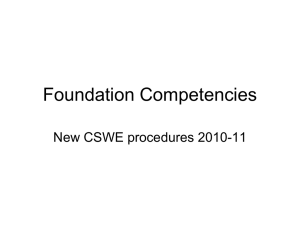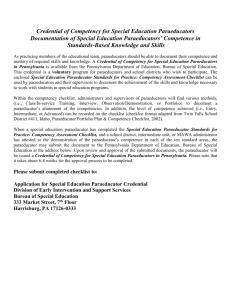Overview Presentation
advertisement
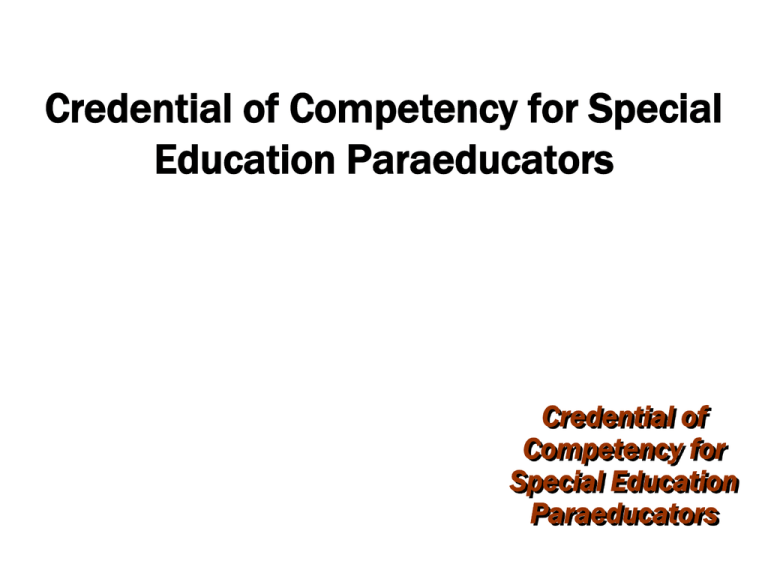
Credential of Competency for Special Education Paraeducators Credential of Competency for Special Education Paraeducators Local Policy • Your local district’s or agency’s policies regarding paraeducator job descriptions, duties, and responsibilities provide the final word! Agenda • Introduction and learner outcomes • What makes a special education paraeducator “highly qualified?” • The Credential of Competency and the purpose of this series • Roles and responsibilities of paraeducators and teachers • Wrap-up Learner Outcomes Participants will: • Describe what makes a special education paraeducator “highly qualified.” • Examine the Special Education Paraeducator Credential of Competency and how to achieve the 10 standards • Discuss purposes of programs for individuals with exceptional learning needs. Highly Qualified Personnel The SEA must establish and maintain qualifications to ensure that personnel are appropriately and adequately prepared and trained, including that personnel have the content knowledge and skills to serve children with disabilities Highly Qualified Personnel • The SEA must have qualifications for related services personnel and paraprofessionals that: – Are consistent with state-approved or state-recognized certification, licensing, registration or other comparable requirements that apply to the professional discipline – Ensure that such personnel who deliver services in their discipline or profession meet the above requirements and have not had certification or licensure waived Highly Qualified Personnel What does this mean for paraeducators in PA? Paraeducator Credential of Competency One way for LEAs to prove highlyqualified status Special Education Paraeducator Credential • Credential available through the PA Department of Education, Bureau of Special Education • 10 Paraeducator Standards for Practice have been established in PA • Essential skills and knowledge have been identified within each standard • Credential is VOLUNTARY Competency Assessment Checklist • Means of documenting competencies required for Paraeducator Credential • Supervisor verifies achievement of items on the checklist • Once all competencies are achieved, paraeducator may apply for the credential Paraeducator Folder (Including Credential of Competency Checklist) To order: Carol Bergman 800-441-3215 x 271 cbergman@pattan.net Standards for Practice 1 Foundations of Special Education 2 Development & Characteristics of Learners 3 Individual Learning Differences 4 Instructional Strategies 5 Learning Environments and Social Interactions Standards for Practice 6 Language 7 Instructional Planning 8 Assessment 9 Professional and Ethical Practice 10 Collaboration Competency Assessment Checklist Each standard has a separate page that includes: • Checklist of essential knowledge and skill competencies applicable to that standard • Employee demographic information • Method used to achieve competency • Level achieved for each competency • Date achieved/supervisor certification Achieving Competencies • Knowledge and skills may be achieved at one of these levels: • Entry • Intermediate • Advanced Achieving Competencies • Competencies may be achieved through one of four methods: • Class/In-service Training • Interview • Observation/Demonstration • Portfolio Class/In-service Training Paraeducator has documented attendance and met requirements of the class/in-service training approved by district/IU • Entry—successfully completed the course and/or training • Intermediate—action plan developed for application in job situations • Advanced—action plan implemented and submitted to supervisor for review Interview When interviewed by the supervisor, a paraeducator responds to questions related to knowledge and skill competencies • Entry—describes basic knowledge and skills with limited evidence of application • Intermediate—describes application of knowledge and skill competencies in job situations • Advanced—describes application of knowledge and skill competencies to job situation and describes how adaptations could be created to meet student needs Class Observation/Demonstration When observed by the supervisor in the classroom or a simulated situation, paraeducator employs knowledge and skill competencies • Entry—performs job duties using basic knowledge & skills requiring some coaching to apply in job situations • Intermediate—sometimes applies knowledge & skill competencies while performing duties in job situations • Advanced—consistently applies knowledge & skills and adapts to meet student needs across all educational settings Portfolio Paraeducator submits to supervisor a predetermined collection of products related to the knowledge and skill competencies • Entry—products meet minimum of predetermined requirements reflecting basic understanding of knowledge and skill competencies with limited application • Intermediate— products meet predetermined requirements and include examples of application of knowledge and skill competencies to job situations • Advanced—products exceed predetermined requirements and include examples of application and adaptation of knowledge and skill competencies to job situations Note! Not all of the skill and knowledge areas can be achieved by attending classes. Some must be demonstrated within your work setting. Example The following need to be demonstrated: • S1 Use strategies, equipment, materials, and technologies, as directed, to accomplish instructional objectives • S2 Use strategies as directed to facilitate effective integration into various settings Planning and Evaluation • Please complete the evaluation form for today’s session. • Using the Paraeducator Development Plan Menu and Action Plan, incorporate the topics covered tonight into your plan. • Sign out and pick up Certificate of Attendance
